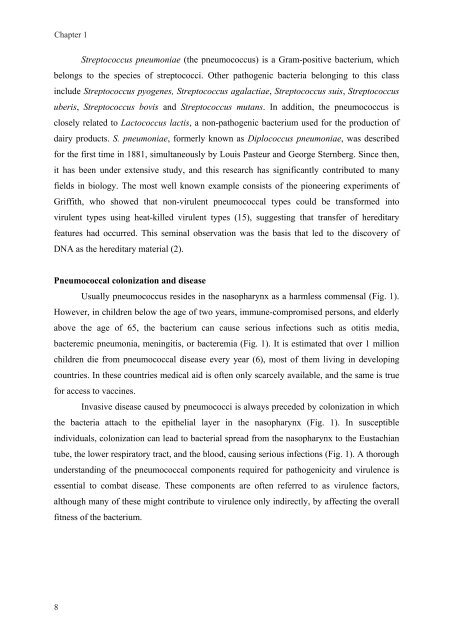Gene regulation in Streptococcus pneumoniae - RePub - Erasmus ...
Gene regulation in Streptococcus pneumoniae - RePub - Erasmus ...
Gene regulation in Streptococcus pneumoniae - RePub - Erasmus ...
Create successful ePaper yourself
Turn your PDF publications into a flip-book with our unique Google optimized e-Paper software.
Chapter 1<br />
8<br />
8<br />
<strong>Streptococcus</strong> <strong>pneumoniae</strong> (the pneumococcus) is a Gram-positive bacterium, which<br />
belongs to the species of streptococci. Other pathogenic bacteria belong<strong>in</strong>g to this class<br />
<strong>in</strong>clude <strong>Streptococcus</strong> pyogenes, <strong>Streptococcus</strong> agalactiae, <strong>Streptococcus</strong> suis, <strong>Streptococcus</strong><br />
uberis, <strong>Streptococcus</strong> bovis and <strong>Streptococcus</strong> mutans. In addition, the pneumococcus is<br />
closely related to Lactococcus lactis, a non-pathogenic bacterium used for the production of<br />
dairy products. S. <strong>pneumoniae</strong>, formerly known as Diplococcus <strong>pneumoniae</strong>, was described<br />
for the first time <strong>in</strong> 1881, simultaneously by Louis Pasteur and George Sternberg. S<strong>in</strong>ce then,<br />
it has been under extensive study, and this research has significantly contributed to many<br />
fields <strong>in</strong> biology. The most well known example consists of the pioneer<strong>in</strong>g experiments of<br />
Griffith, who showed that non-virulent pneumococcal types could be transformed <strong>in</strong>to<br />
virulent types us<strong>in</strong>g heat-killed virulent types (15), suggest<strong>in</strong>g that transfer of hereditary<br />
features had occurred. This sem<strong>in</strong>al observation was the basis that led to the discovery of<br />
DNA as the hereditary material (2).<br />
Pneumococcal colonization and disease<br />
Usually pneumococcus resides <strong>in</strong> the nasopharynx as a harmless commensal (Fig. 1).<br />
However, <strong>in</strong> children below the age of two years, immune-compromised persons, and elderly<br />
above the age of 65, the bacterium can cause serious <strong>in</strong>fections such as otitis media,<br />
bacteremic pneumonia, men<strong>in</strong>gitis, or bacteremia (Fig. 1). It is estimated that over 1 million<br />
children die from pneumococcal disease every year (6), most of them liv<strong>in</strong>g <strong>in</strong> develop<strong>in</strong>g<br />
countries. In these countries medical aid is often only scarcely available, and the same is true<br />
for access to vacc<strong>in</strong>es.<br />
Invasive disease caused by pneumococci is always preceded by colonization <strong>in</strong> which<br />
the bacteria attach to the epithelial layer <strong>in</strong> the nasopharynx (Fig. 1). In susceptible<br />
<strong>in</strong>dividuals, colonization can lead to bacterial spread from the nasopharynx to the Eustachian<br />
tube, the lower respiratory tract, and the blood, caus<strong>in</strong>g serious <strong>in</strong>fections (Fig. 1). A thorough<br />
understand<strong>in</strong>g of the pneumococcal components required for pathogenicity and virulence is<br />
essential to combat disease. These components are often referred to as virulence factors,<br />
although many of these might contribute to virulence only <strong>in</strong>directly, by affect<strong>in</strong>g the overall<br />
fitness of the bacterium.

















